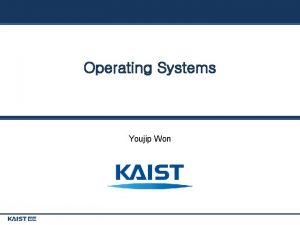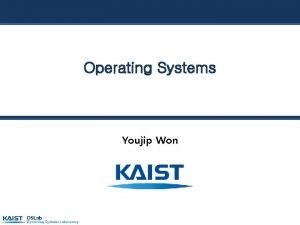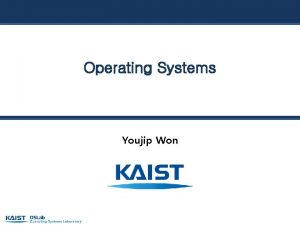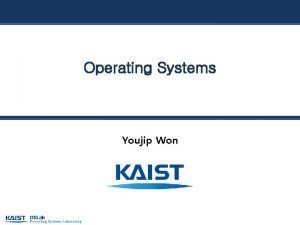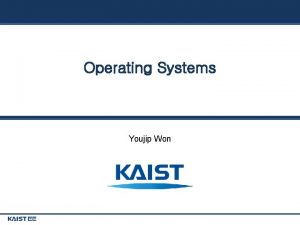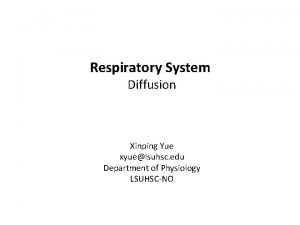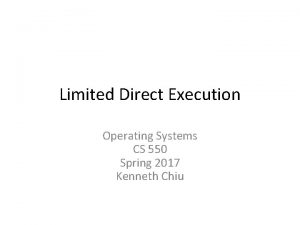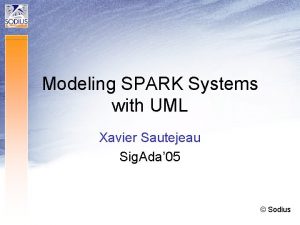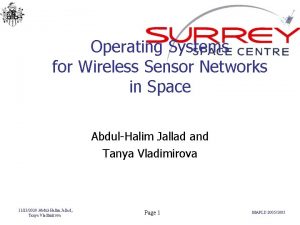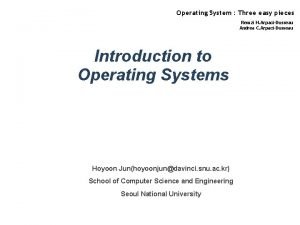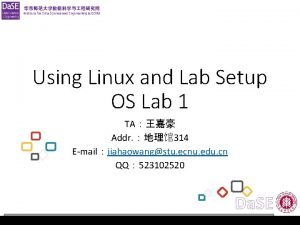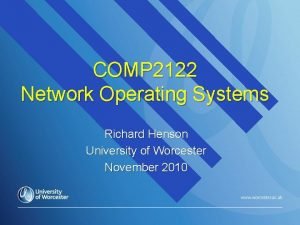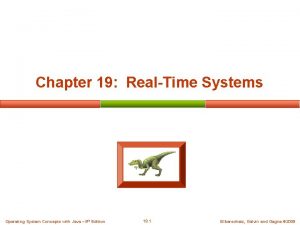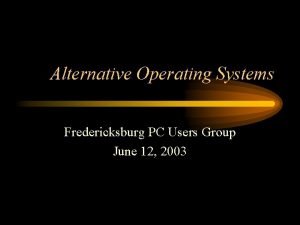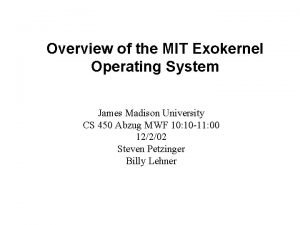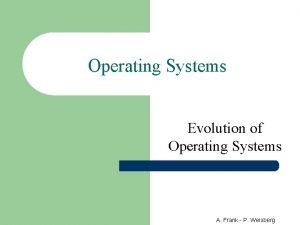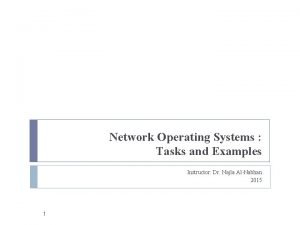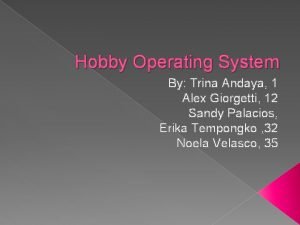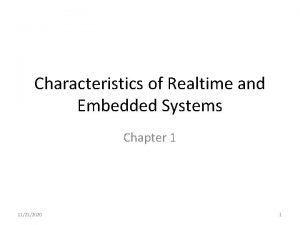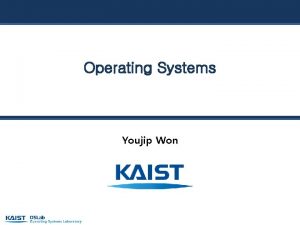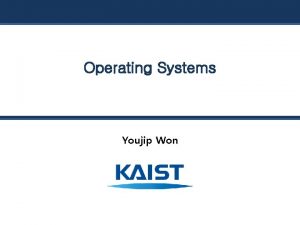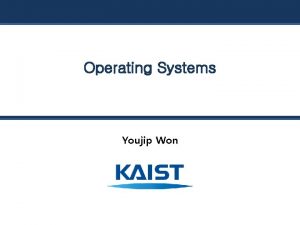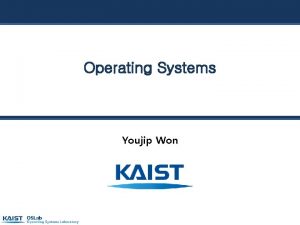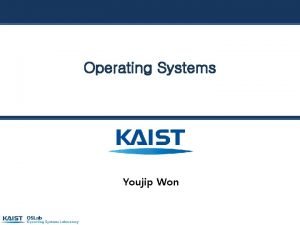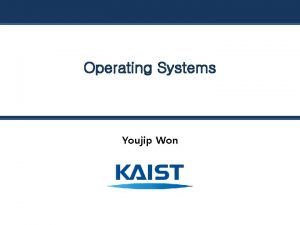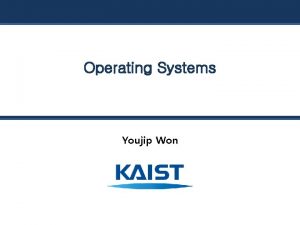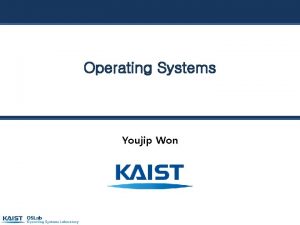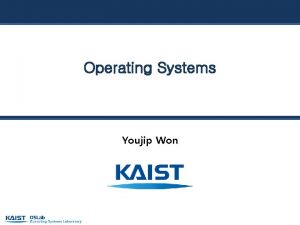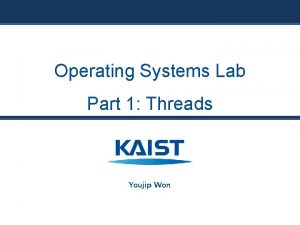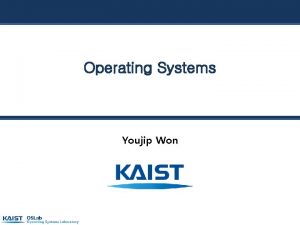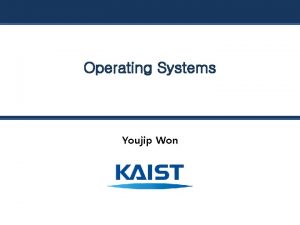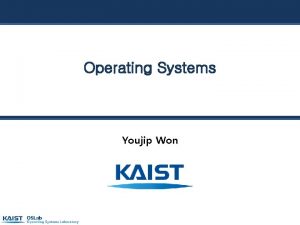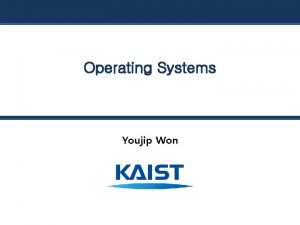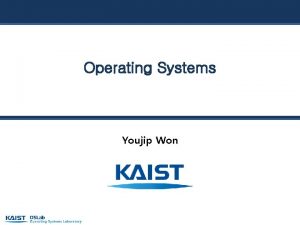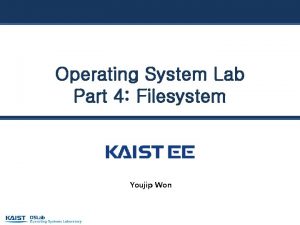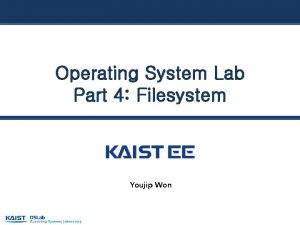Operating Systems Youjip Won 6 Mechanism Limited Direct


































- Slides: 34

Operating Systems Youjip Won

6. Mechanism: Limited Direct Execution Youjip Won 2

How to efficiently virtualize the CPU with control? The OS needs to share the physical CPU by time sharing. Issue Performance: How can we implement virtualization without adding excessive overhead to the system? Control: How can we run processes efficiently while retaining control over the CPU? Youjip Won 3

Direct Execution Just run the program directly on the CPU. OS 1. 2. 3. 4. 5. 6. Program Create entry for process list Allocate memory for program Load program into memory Set up stack with argc / argv Clear registers Execute call main() 9. Free memory of process 10. Remove from process list 7. Run main() 8. Execute return from main() Without limits on running programs, the OS wouldn’t be in control of anything and thus would be “just a library” Youjip Won 4

Recap: Process Creation 1. Load a program code into memory, into the address space of the process. Programs initially reside on disk in executable format. OS perform the loading process lazily. Loading pieces of code or data only as they are needed during program execution. 2. The program’s run-time stack is allocated. Use the stack for local variables, function parameters, and return address. Initialize the stack with arguments argc and the argv array of main() function Youjip Won 5

Recap: Process Creation (Cont. ) 3. The program’s heap is created. Used for explicitly requested dynamically allocated data. Program request such space by calling malloc() and free it by calling free(). 4. The OS do some other initialization tasks. input/output (I/O) setup 5. Each process by default has three open file descriptors. Standard input, output and error Start the program running at the entry point, namely main(). The OS transfers control of the CPU to the newly-created process. Youjip Won 6

Problem Issue 1 User can do wrong thing. What if? int *i ; i = 0 ; *i = 1 ; Issue 2 Getting the control back from CPU is not easy. What if? i = -1 ; while (i <0) do something; Youjip Won 7

Problem 1: Restricted Operation What if a process wishes to perform some kind of restricted operation such as … Issuing an I/O request to a disk Gaining access to more system resources such as CPU or memory Solution 1: Grant everything. Solution: Use protected control transfer User mode: Applications do not have full access to hardware resources. Kernel mode: The OS has access to the full resources of the machine Youjip Won 8

System Call Allow the kernel to carefully expose certain key pieces of functionality to user program, such as … Accessing the file system Creating and destroying processes Communicating with other processes Allocating more memory Youjip Won 9

Call flow(Pintos): write() User program main() { write(“……”) } pintos/src/lib/user/syscall. c int write(…) { return syscall 3(SYS_WRITE, fd, buffer, size); } User stack … syscall 3(…). {. …. push arg 2 push arg 1 arg 2 push arg 0 arg 1 push number arg 0 int 0 x 30 } number Youjip Won Stack Pointer(esp) 10

Definitions of system calls (src/lib/user/syscall. c) Youjip Won 11

Systemcall in pintos(systemcall-nr. h) Youjip Won 12

Register systemcall handler at IDT Interrupt descriptor table Table of the locations of the interrupt handlers for the associated interrupt number. Register the systemcall handler at interrupt 0 x 30(src/userprog/syscall. c). Interrupt Descriptor table 0 x 0 divide_error() debug() nmi() …… 0 x 30 syscall_handler( ) … Youjip Won 13

Call flow(Pintos): write() User program main() { write(“……”) } Kernel 0 x 0 Interrupt Vector table divide_error() debug() nmi() …… pintos/src/lib/user/syscall. c int write(…) { return syscall 3(…); } … syscall 3(…) { … push arg 2 push arg 1 push arg 0 push number int 0 x 30 } 0 x 30 syscall_handler( ) … User stack. . . arg 2 arg 1 arg 0 number Stack Pointer(esp) Youjip Won 14

Call process of System call (Pintos) User Kernel User program main() { write(“……”) } return 0 x 0 int write(…) { return syscall 3(…); } … syscall 3(…) { … push arg 2 push arg 1 push arg 0 push number int 0 x 30 } divide_error() debug() …… 0 x 30 Currently empty. pintos/src/userprog/syscall. c nmi() call pintos/src/lib/user/syscall. c Interrupt Vector table syscall_handler( ) … syscall_handler( intr_frame *f) { printf ("system call!n"); thread_exit (); } User stack. . . arg 2 arg 1 arg 0 number Stack Pointer(esp) Youjip Won 15

Implementation of write()(src/filesys. c) How do you bind the write() system call to file_write()? off_t file_write (struct file *file, const void *buffer, off_t size) { off_t bytes_written = inode_write_at (file->inode, buffer, size, file->pos); file->pos += bytes_written; return bytes_written; } divide_error() debug() main() { write(“…… ”) } int write(…) { return syscall 3(…); } nmi() syscall_handler( intr_frame *f) { ? ? ? …… file_write() } syscall_handler( ) … Youjip Won 16

Key Concept of System Call Trap instruction int n Raise the privilege level to kernel mode Save registers at the kernel stack. (eip, cs, eflags, esp, ss) Locates the destination in the kernel Jumps to the destination. Interrupt number for system call : 0 x 64 @ xv 6, 0 x 30 @Pintos e. g. int 0 x 64 Return-from-trap instruction Return into the calling user program Reduce the privilege level back to user mode Youjip Won 17

What code to run in trap? Sources of trap Completion of disk IO Keyboard interrupt System call trap handler: the code to run for each interrupt number (trap number) Trap table The address of the trap handlers. Hardware Informs the location of the trap table to OS when booting. The instruction to inform the location of the trap table is also privileged instruction. You cannot execute this instruction in user mode. Youjip Won 18

Invention of System Call ATLAS (1962 -1971) World’s first supercomputer with virtual memory(paging), extracode (system call), … Youjip Won 19

Computer invented by Britain declares war on Germany in 1939 Youjip Won 20

Limited Direction Execution OS @ boot (kernel mode) initialize trap table OS @ run (kernel mode) Create entry for process list Allocate memory for program Load program into memory Setup user stack with argv Fill kernel stack with reg/PC return-from -trap Hardware remember address of … syscall handler Hardware restore regs from kernel stack move to user mode jump to main Youjip Won Program (user mode) Run main() … Call system trap into OS 21

Limited Direction Execution (Cont. ) OS @ run (kernel mode) Hardware Program (user mode) (Cont. ) Handle trap Do work of syscall return-from-trap save regs to kernel stack move to kernel mode jump to trap handler restore regs from kernel stack move to user mode jump to PC after trap … return from main trap (via exit()) Free memory of process Remove from process list Youjip Won 22

Problem 2: Switching Between Processes How can the OS regain control of the CPU so that it can switch between processes? A cooperative Approach: Wait for system calls A Non-Cooperative Approach: The OS takes control Youjip Won 23

A cooperative Approach: Wait for system calls Processes periodically give up the CPU by making system calls such as yield. The OS decides to run some other task. Application also transfer control to the OS when they do something illegal. Divide by zero Try to access memory that it shouldn’t be able to access Ex) Early versions of the Macintosh OS, The old Xerox Alto system A process gets stuck in an infinite loop. Reboot the machine Youjip Won 24

A Non-Cooperative Approach: OS Takes Control A timer interrupt During the boot sequence, the OS start the timer. The timer raise an interrupt every few milliseconds. When the interrupt is raised : The currently running process is suspended. Save enough of the state of the process. A pre-configured interrupt handler in the OS runs. A timer interrupt gives OS the ability to run again on a CPU. Youjip Won 25

Timer interrupt Programming the timer interval Programmed to interrupt CPU periodically Single CPU: PIT (Programmable Interval Timer) Multiple CPU: APIC(Advanced Programmable Interrupt Controller) LAPIC: Local APIC per processor IO APIC on system bus // timer while (1) i = INTERVAL ; while (--i > 0) ; raise interrupt ; Youjip Won 26

Timer interrupt (1963) Youjip Won 27

J. Mc. Carthy (1927 – 2011) Pioneers of AI along with Alan Turing, Marvin Minsky, Allen Newell. The first to use the term “Artificial Intelligence. ” Inventor of ‘Lisp’ which is a mother of ‘scheme’, a function programming language. Youjip Won 28

Saving and Restoring Context Scheduler makes a decision: Whether to continue running the current process, or switch to a different one. If the decision is made to switch, the OS executes context switch. Youjip Won 29

Context Switch A low-level piece of assembly code Save a few register values for the current process onto its kernel stack General purpose registers PC kernel stack pointer Restore a few for the soon-to-be-executing process from its kernel stack Switch to the kernel stack for the soon-to-be-executing process Youjip Won 30

Limited Direct Execution Protocol (Timer interrupt) OS @ boot (kernel mode) initialize trap table Hardware remember address of … syscall handler timer handler start interrupt timer start timer interrupt CPU in X ms OS @ run (kernel mode) Hardware Program (user mode) Process A … timer interrupt save regs(A) to k-stack(A) move to kernel mode jump to trap handler Youjip Won 31

Limited Direct Execution Protocol (Timer interrupt) OS @ run (kernel mode) Hardware Program (user mode) (Cont. ) Handle the trap Call switch() routine save regs(A) to proc-struct(A) restore regs(B) from proc-struct(B) switch to k-stack(B) return-from-trap (into B) restore regs(B) from k-stack(B) move to user mode jump to B’s PC Process B … Youjip Won 32

The xv 6 Context Switch Code 1 # void swtch(struct context **old, struct context *new); 2 # 3 # Save current register context in old 4 # and then load register context from new. 5. globl swtch 6 swtch: 7 # Save old registers 8 movl 4(%esp), %eax # put old ptr into eax 9 popl 0(%eax) # save the old IP 10 movl %esp, 4(%eax) # and stack 11 movl %ebx, 8(%eax) # and other registers 12 movl %ecx, 12(%eax) 13 movl %edx, 16(%eax) 14 movl %esi, 20(%eax) 15 movl %edi, 24(%eax) 16 movl %ebp, 28(%eax) 17 18 # Load new registers 19 movl 4(%esp), %eax # put new ptr into eax 20 movl 28(%eax), %ebp # restore other registers 21 movl 24(%eax), %edi 22 movl 20(%eax), %esi 23 movl 16(%eax), %edx 24 movl 12(%eax), %ecx 25 movl 8(%eax), %ebx 26 movl 4(%eax), %esp # stack is switched here 27 pushl 0(%eax) # return addr put in place 28 ret # finally return into new ctxt Youjip Won 33

Worried About Concurrency? What happens if, during interrupt or trap handling, another interrupt occurs? OS handles these situations: Disable interrupts during interrupt processing Use a number of sophisticated locking schemes to protect concurrent access to internal data structures. Youjip Won 34
 Youjip won
Youjip won Youjup
Youjup Common concurrency mechanisms
Common concurrency mechanisms Youjipp
Youjipp Youjip
Youjip Ficks law
Ficks law Multiple valve springs are used primarily to
Multiple valve springs are used primarily to Limited direct execution protocol
Limited direct execution protocol A modern approach to systems analysis and design
A modern approach to systems analysis and design Nippon data systems limited
Nippon data systems limited Rtdas system
Rtdas system Adobe spark uml
Adobe spark uml Expert system limited
Expert system limited Operation system example
Operation system example Evolution of operating systems
Evolution of operating systems Components of operating systems
Components of operating systems Operating system components
Operating system components Wsn operating systems
Wsn operating systems Remzi h arpaci-dusseau
Remzi h arpaci-dusseau Operating system lab
Operating system lab Open source operating system
Open source operating system Tanenbaum os
Tanenbaum os File management in operating system
File management in operating system Design issues in distributed system
Design issues in distributed system Early operating systems
Early operating systems Real-time operating systems
Real-time operating systems Can we make operating systems reliable and secure
Can we make operating systems reliable and secure Alternative operating systems
Alternative operating systems Exo kernel
Exo kernel Operating system internals and design principles
Operating system internals and design principles Evolution of operating systems
Evolution of operating systems Give examples of nos network operating system
Give examples of nos network operating system Msdn operating systems subscription
Msdn operating systems subscription Hobby os
Hobby os Characteristics of embedded system
Characteristics of embedded system
